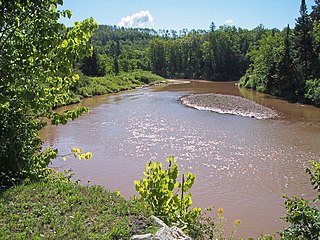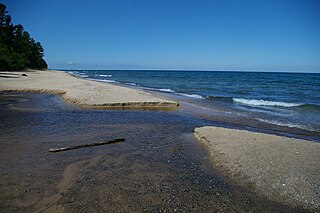
Lake Michigan is one of the five Great Lakes of North America and the only one located entirely within the United States. The other four Great Lakes are shared by the U.S. and Canada. It is the second-largest of the Great Lakes by volume and the third-largest by surface area, after Lake Superior and Lake Huron. To the east, its basin is conjoined with that of Lake Huron through the wide Straits of Mackinac, giving it the same surface elevation as its easterly counterpart; the two are technically a single lake.

Lake Huron is one of the five Great Lakes of North America. Hydrologically, it comprises the easterly portion of Lake Michigan–Huron, having the same surface elevation as its westerly counterpart, to which it is connected by the 5-mile-wide (8.0 km), 20-fathom-deep Straits of Mackinac. It is shared on the north and east by the Canadian province of Ontario and on the south and west by the state of Michigan in the United States. The name of the lake is derived from early French explorers who named it for the Huron people inhabiting the region. The Huronian glaciation was named due to evidence collected from Lake Huron region. The northern parts of the lake include the North Channel and Georgian Bay. Across the lake to the southwest is Saginaw Bay. The main inlet is the St. Marys River, and the main outlet is the St. Clair River.

The Kalamazoo River is a river in the U.S. state of Michigan. The river is 130 miles (210 km) long from the junction of its North and South branches to its mouth at Lake Michigan, with a total length extending to 178 miles (286 km) when one includes the South Branch. The river's watershed drains an area of approximately 2,020 square miles (5,200 km2) and drains portions of eight counties in southwest Michigan: Allegan, Barry, Eaton, Van Buren, Kalamazoo, Calhoun, Jackson, Hillsdale, Kent and Ottawa. The river has a median flow of 1,863 cubic feet per second (52.8 m3/s) at New Richmond, upstream from its mouth at Saugatuck.

The Yellow Dog River flows through Marquette County in the Upper Peninsula of the U.S. state of Michigan. It is 31.6 miles (50.9 km) in length, with about 85 miles (137 km) of tributaries. The main branch begins at the outflow from Bulldog Lake in the Ottawa National Forest on the boundary between Baraga and Marquette counties. The river's mouth is on Lake Independence, near Big Bay, Michigan, and is part of the Lake Superior watershed.

The Ontonagon River is a river flowing to Lake Superior on the western Upper Peninsula of Michigan in the United States. The main stem of the river is 25 miles (40 km) long and is formed by a confluence of several longer branches, portions of which have been collectively designated as a National Wild and Scenic River. Several waterfalls occur on the river including Agate Falls and Bond Falls.

Michigan consists of two peninsulas that lie between east longitude, and are separated by the Straits of Mackinac, and some nearby islands. With the exception of two small areas that are drained by the Mississippi River by way of the Wisconsin River in the Upper Peninsula and by way of the Kankakee-Illinois River in the Lower Peninsula, Michigan is drained by the Great Lakes-St. Lawrence watershed and is the only state with the majority of its land thus drained.
The Cranberry River is a 20.0-mile-long (32.2 km) river in Ontonagon County on the Upper Peninsula of Michigan in the United States. It is a tributary of Lake Superior.
The Flintsteel River is a 28.3-mile-long (45.5 km) river in Ontonagon County on the Upper Peninsula of Michigan in the United States. It is a tributary of Lake Superior.

The Hurricane River is a 6.4-mile-long (10.3 km) river in Alger County in the Upper Peninsula of Michigan in the United States. It empties into Lake Superior in the Pictured Rocks National Lakeshore. There is a campground at the mouth of the river which is also the beginning of a trail that leads past various old shipwrecks to the historic Au Sable Lighthouse. The mouth of the river is also very near the eastern end of a stretch of relatively straight shoreline known as Twelvemile Beach.
The Iron River is a 2.7-mile-long (4.3 km) river in Marquette County on the Upper Peninsula of Michigan in the United States. It is a short stream flowing from the outlet of Lake Independence east to Lake Superior.
The Jumbo River is a 15.5-mile-long (24.9 km) tributary of the East Branch Ontonagon River in Iron and Houghton counties on the Upper Peninsula of Michigan in the United States. Via the East Branch, its waters flow north to the Ontonagon River and then to Lake Superior.
The Little Cranberry River is an 11.3-mile-long (18.2 km) river in Ontonagon County, on the Upper Peninsula of Michigan, in the United States. It is a tributary of Lake Superior.
The Little Iron River is a 17.9-mile-long (28.8 km) river in western Ontonagon County on the Upper Peninsula of Michigan in the United States. It is a tributary of Lake Superior.
The Little Presque Isle River is a 21.3-mile-long (34.3 km) tributary of the Presque Isle River on the Upper Peninsula of Michigan, flowing to Lake Superior.
The Little Sturgeon River is a 12.3-mile-long (19.8 km) river in Cheboygan County, Michigan, in the United States. It is a tributary of the Indian River, part of the Mullett Lake/Cheboygan River system flowing to Lake Huron.
The Potato River is a 10.3-mile-long (16.6 km) river in Ontonagon County on the Upper Peninsula of Michigan in the United States. It is a tributary of Lake Superior.
The Vermilac River is an 8.8-mile-long (14.2 km) river in Baraga County on the Upper Peninsula of Michigan in the United States. It is a tributary of Worm Lake, the outlet of which is the Rock River, which flows to the Sturgeon River and eventually to Lake Superior.
Sturgeon River is a 106-mile-long (171 km) river in Baraga County and Houghton counties in the U.S. state of Michigan. 25.0 miles (40.2 km) of the river were added to the National Wild and Scenic Rivers System in 1992.
The Little River is a 35.2-mile-long (56.6 km) tributary of the Menominee River on the Upper Peninsula of Michigan in the United States. It rises south of Stephenson and flows south to join the Menominee River 3 miles (5 km) upstream from the twin cities of Menominee, Michigan-Marinette, Wisconsin, on Lake Michigan.









